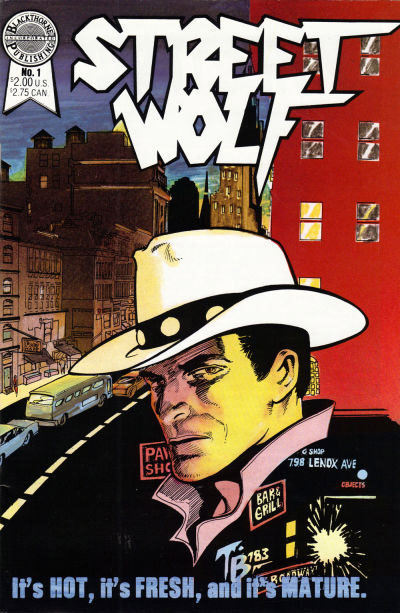Here's the scoop on STREET WOLF from blogger Christopher Mills:
Street Wolf
Refreshing, huh?
Street Wolf is Nathan Blackhorse, a handsome, cowboy-hat-and-boots wearing gentleman of Native American descent, a skilled martial artist who lives in a pre-Giuliani New York City. He's respected by the cops and criminals alike, and his past is suitably mysterious.
Harris' triumph, though, is the pleasantly unique and original character of Nathan Blackhorse. A street hero who is genuinely heroic, working with the police gathering evidence and intelligence, but not afraid to mix things up if necessary. The master stroke is that he's an American Indian--a minority still woefully under-represented in the entertainment media. Blackhorse is given an intriguingly mysterious past and a supporting cast with a lot of potential; too bad there were no more issues.
REPORTER: What kind of Indian are you?
STREET WOLF: Navajo, I think.
REPORTER: You 'think'?
STREET WOLF: I'm American. That's what's important.
That Street Wolf isn't sure of his tribal heritage is possible. That he considers himself an American first and an Indian second is unlikely. What's the point of identifying himself as an Indian if it doesn't mean anything to him? And why identify himself as an American when that isn't in question? If he was born in the US, as he indicated, he's American by definition.
Michael Sheyahshe is impressed with Street Wolf because he's an urban dweller who doesn't dress or act like a typical Indian. I'm not impressed because he's an Indian in name only. Since he doesn't have any cultural values or traits associated with Indians, he could just as easily belong to any ethnicity.
I disagree with Mills about the black and white art. I'd say it's superior for a independent book and better than the art in many mainstream comics. My problem is that the stories are standard cop/private-eye fare. We've seen tales like these a thousand times before on TV and elsewhere.
Mills gives STREET WOLF four of six bullets. Yes, 3-4 bullets out of six is about right. To me that's an average comic, not something to rave about.
So I wouldn't rush to buy STREET WOLF #1-3 from MileHighComics.com or elsewhere. But they're worth checking out if you want a different take on Native heroes in comics. If you're a collector of Native-themed comics, you probably should have at least one issue of STREET WOLF.


6 comments:
Also, "Blackhorse" sounds more like a generic made-up didethematic "Indian name" (i.e., animal + adjective) then anything authentically Dine in origin. And depending on the character's age, it would be far more likely that he was born in Indian Country and then "adopted" into a white family and thereby lost contact with his tribe, a sadly common ocurence before the Indian Child Welfare Act.
Yes, the backstory is unlikely, but it's not impossible.
Note that the name "Bluehorse" is found among the Diné. I believe Milton Bluehorse was president of the Navajo Nation briefly.
Nathan Blackhorse like a lot of Native Americans and African Americans adopted into Caucasian society, have been removed from their heritage as children.
He defends his American origin in the same way an African American has to push for inclusion even in his own country.
Yes, there was a complex back-story that Mark Wayne Harris constructed but as with most fictional characters, it must be rolled out in sections. There were quite a lot of avenues open to us when we co-created the stories.
The chance was taken from us when Blackthorne Publishng folded.
In regards to the lack of firearms used by the criminals, I lived in the Bronx in the 70's and 80's. Most of the gangs in New York back then couldn't get that many guns. It was a different era then. Sure, guns were available but not as many as today.
Nathan, like a lot of non white comic book characters we worked on was part complex personality and part stereotype, in order to stand out.
I'll end with this; Mark Wayne Harris was very thorough in his research when he wrote. He would send me tons of faxes to my offices when working on a project.
Dennis Morales Francis
DiD Publishing Inc.
Rolling out a complex backstory starting with issue #4 wasn't great planning. The backstory should've started appearing in #1 to entice readers.
I don't know about the availability of guns in the Bronx, but gun ownership has declined overall since the story's timeframe:
http://www.gunfaq.org/2013/03/four-decade-decline-in-gun-ownership/
The New York Times is reporting a four decade decline in gun ownership in the home, based on 2012 General Social Survey data released last Thursday.
The share of American households with guns has declined over the past four decades, with some of the most surprising drops in the South and the Western mountain states, where guns are deeply embedded in the culture.
The GSS survey indicates that the household gun ownership rate has fallen from an average of 50 percent in the 1970s to 49 percent in the 1980s, 43 percent in the 1990s and 35 percent in the 2000s. In 2012, the share of American households with guns was 34 percent.
And a relative paucity of guns doesn't quite address my point, which was:
"The first time he faces a crook with a firearm, Street Wolf is dead and the story is over in a page."
How long did you plan to go before the first criminal pointed a gun at Street Wolf? Six months? A year or two? Forever?
Post a Comment